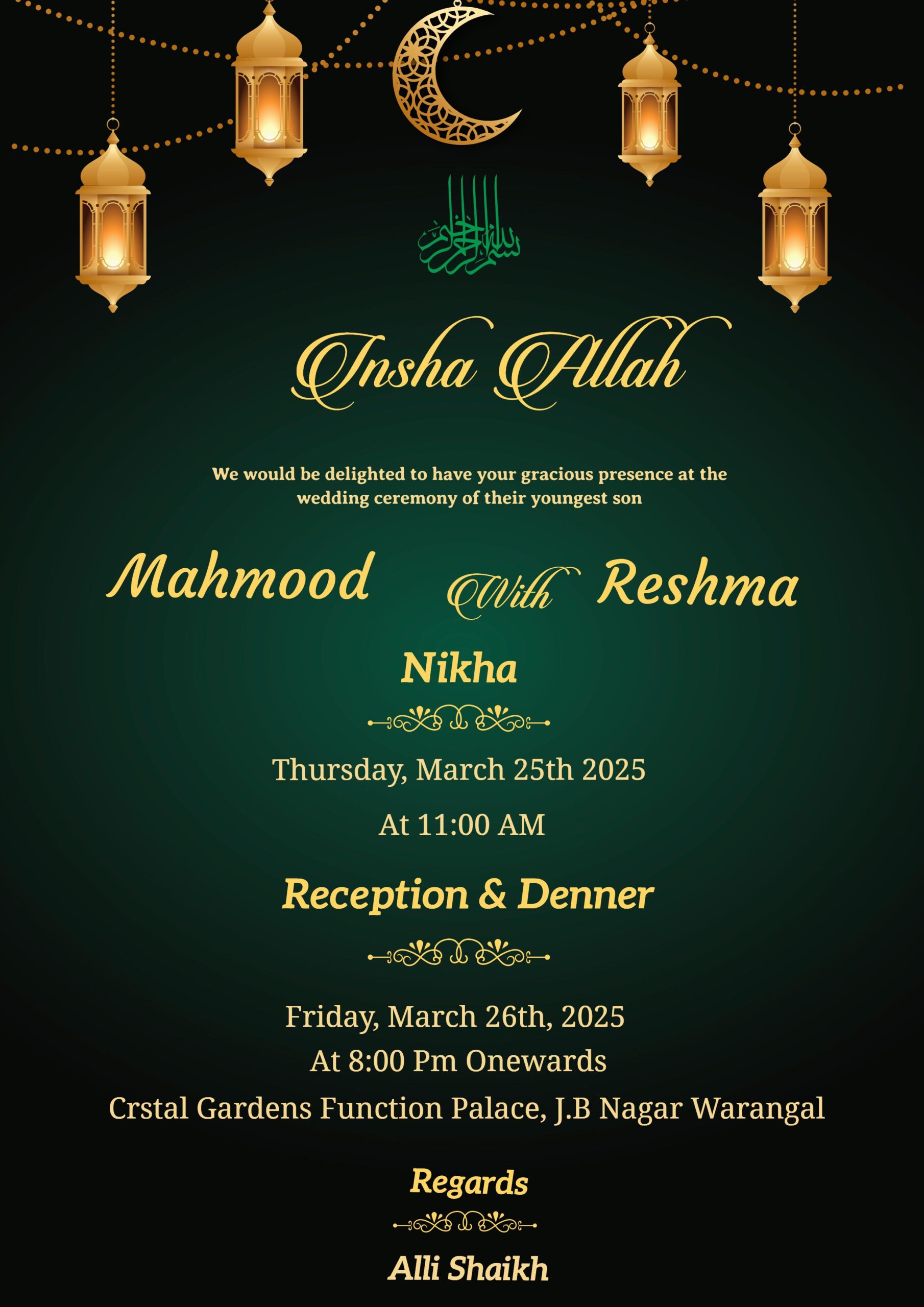
Customize 30+ Wedding Invitation Cards for Muslim
Introduction
In the age of technology, digital wedding invitation cards for muslim have become a popular and eco-friendly alternative to traditional paper invites. These digital cards offer numerous advantages, including cost savings, ease of distribution, and the ability to incorporate multimedia elements. For Muslim weddings, which are often rich in tradition and cultural significance, digital invitations can be tailored to reflect the beauty and depth of Islamic customs and aesthetics. This comprehensive guide explores the various aspects of creating digital wedding invitation cards for Muslim weddings, from design elements to cultural considerations.
The Essence of Muslim Weddings
Muslim weddings, also known as Nikah ceremonies, are a profound blend of religious, cultural, and familial traditions. These weddings are celebrated with a series of events that often include the Nikah (marriage contract), Mehndi (henna night), Walima (reception), and other regional customs. Each of these events has its own significance and charm, which can be beautifully encapsulated in a digital invitation.
Design Elements
-
Islamic Art and Calligraphy: Incorporating Islamic art, such as intricate geometric patterns, arabesques, and traditional calligraphy, can enhance the elegance of the invitation. Quranic verses or phrases like “Bismillah” (In the name of Allah) can be artistically integrated to bless the occasion.
-
Color Palette: Traditional colors such as gold, green, and white are often preferred for Muslim wedding invitations. Gold symbolizes prosperity, green represents peace and paradise, and white denotes purity. These colors can be used as the primary palette or as accents to highlight important details.
-
Typography: Selecting the right fonts is crucial. Elegant, readable scripts that emulate traditional Arabic calligraphy can add a touch of authenticity and sophistication to the invitation.
-
Multimedia Integration: Digital invitations can include multimedia elements such as background music, video messages from the couple, or animated graphics. A recitation of a Quranic verse or a traditional Islamic song (Nasheed) can add a spiritual touch.
-
Interactive Features: Features like RSVP buttons, event calendars, and links to wedding websites or gift registries can be seamlessly integrated into digital invitations, enhancing the convenience for guests.
Cultural and Religious Considerations
-
Respectful Imagery: Ensure that all imagery and language used in the invitation are respectful of Islamic values. Avoid any depiction of living beings, particularly human and animal forms, which is generally discouraged in Islamic art.
-
Religious Phrases: Including phrases like “Insha’Allah” (God willing), “Mash’Allah” (What God has willed), and “Alhamdulillah” (Praise be to God) can imbue the invitation with a sense of religious devotion and humility.
-
Event Descriptions: Provide clear and concise descriptions of each event, explaining their significance. This can be particularly helpful for guests who may not be familiar with Muslim wedding customs.
Creating the Digital Invitation
-
Choose a Platform: Numerous platforms and software options are available for creating digital invitations, ranging from professional graphic design tools like Adobe Illustrator to user-friendly online services like Canva, Evite, or Paperless Post.
-
Template Selection: Start with a template that suits the aesthetic and tone of your wedding. Many platforms offer templates specifically designed for Muslim weddings, complete with appropriate motifs and calligraphy.
-
Customization: Personalize the template with your details, including names, dates, locations, and specific instructions for guests. Use high-resolution images and ensure that all text is clear and legible.
-
Multimedia Additions: Add any multimedia elements you wish to include, such as music or videos. Ensure that these elements are of high quality and do not overshadow the main content of the invitation.
-
Proofreading and Testing: Before sending out the invitations, proofread all text for any errors and test all interactive elements to ensure they function correctly. This step is crucial to maintain the professionalism and accuracy of your invitation.
Distribution and Follow-Up
-
Guest List Management: Use digital tools to manage your guest list efficiently. Platforms like Google Sheets or specialized wedding management software can help track RSVPs and guest preferences.
-
Sending Invitations: Distribute the invitations via email, social media, or messaging apps. Ensure that you respect privacy and security by using secure methods of sharing personal information.
-
Follow-Up: Send reminders and updates as the wedding day approaches. Digital platforms often allow automated reminders to ensure guests are well-informed and prepared.
Environmental and Economic Benefits
-
Eco-Friendly: Digital invitations significantly reduce paper waste and the carbon footprint associated with printing and mailing traditional invitations. This choice aligns with the Islamic principle of stewardship of the Earth (Khilafah).
-
Cost-Effective: Digital invitations can be more cost-effective than traditional ones, eliminating printing and postage costs. This allows for a more budget-friendly wedding planning process without compromising on style and elegance.
Examples and Inspirations
-
Classic Elegance: A digital invitation featuring gold calligraphy on a deep green background, with delicate geometric patterns framing the text. The invitation opens with a soft recitation of a Quranic verse.
-
Modern Minimalist: A sleek, white digital invitation with minimalist typography and subtle gold accents. A video message from the couple plays upon opening, inviting guests personally to the celebration.
-
Cultural Fusion: A vibrant invitation combining traditional Islamic designs with modern elements, such as animated graphics and interactive RSVP buttons. Background music featuring a blend of traditional and contemporary sounds adds a unique touch.
Conclusion
Digital wedding invitations for Muslim weddings offer a beautiful and practical way to blend tradition with modern technology. They provide a platform to showcase the rich cultural and religious heritage of Muslim weddings while offering convenience and environmental benefits. By carefully considering design elements, cultural sensitivities, and the technical aspects of creating and distributing digital invitations, couples can ensure their wedding invitations are both stunning and respectful of their cherished traditions.


